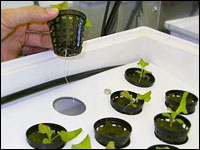
Go wet, young IT man (and woman). Your parched, imperiled planet needs you.
When it comes to creating a future filled with fresh, drinkable water, information technology professionals have a significant career opportunity in a mega-sized market. The very economic survival of a thirsty, arid Earth — with the U.S. southwest as a prime example — depends a great deal on properly applying the skills and expertise of app developers and systems administrators to the mapping, modeling and management of water across the world.
In the U.S., shortages are causing states like California to declare water emergencies, introduce rationing, set usage limits, and levy fines and penalties for violators. California’s three-year drought and a dispute over the endangered Delta smelt have put water districts under pressure to cut their customers’ consumption while conserving as much as possible. Each drop counts … and will be counted. No more overwatering, broken sprinklers and leaking pipes sending drinkable water flowing or spraying into adjacent private properties, public rights-of-way and city storm drains on its way to the sea.
“Wired water” — the use of information technology (hardware, software, telecom, networking, services) for water control — could become a US$20 billion market, according to Sharon Nunes, vice president for IBM’s Big Green Innovations global initiative for water management.
“There’s a lot of stress on water systems around the world,” said Nunes. “With a limited supply, you’d better be able to manage it.”
Big Blue Sea
IBM has jumped in fully clothed. Big Blue’s Big Green portfolio of smart water services and technologies uses advanced analytics developed by mathematicians in IBM’s labs, as well as the company’s information management, technology services, and business consulting capabilities.
To replace workers dispatched in trucks to check on water quality and levels and look for pipeline leaks and breaks, IBM automates the process with systems to monitor reservoirs, rivers and harbors, placing small sensors in the water and along pipelines right up to homes and businesses. Back-end software analyzes the resulting data and displays it on computer dashboards that enable water managers to monitor their systems and head off problems like leaks or contamination.
The IT giant, determined to expand beyond traditional computer services, is moving fast because it’s seeing Big Water just keep getting bigger. Revenues of the world’s water-related businesses will rise from $522 billion in 2007 to nearly $1 trillion by 2020, according to New York-based Lux Research. The firm’s April 2009 report “Water Cultivation: The Path to Profit in Meeting Water Needs” predicts that a world facing water shortages will need a new “water cultivation” approach characterized by efficiency, reuse and source diversification.
Tools like smart meters that limit lawn-watering to nighttime hours, or sensors that detect leaks in pipes, are just a few of many ways computers can help monitor water use, Lux senior analyst Michael LoCascio said. The real change must come in our mindset about the wet stuff.
“The world will avert crisis by cultivating water as a durable asset rather than throwing it away as a consumable — creating growth opportunities in everything from oxidizing new contaminants to rehabilitating creaking infrastructure,” LoCascio told TechNewsWorld.
Though computers have been used for decades in the large-scale mapping of ground and surface water sources, today’s water crisis has pushed the water industry toward computer automation solutions that range from the largest national and international projects down to the individual homeowner’s front yard.
H2O to Go
All known forms of life depend on water. To function properly and avoid dehydration, the human body (itself three-quarters water) requires between one and seven liters per day. Nonetheless, although Earth is often referred to as the “water planet,” only 2.5 percent of the supply is fresh, and three quarters of that is locked up in ice at the North and South poles.
Some 18 percent of the world population lacks access to potable water, according to United Nations’ statistics, and demand is expected to rise by 40 percent in the next 20 years. However, tracking this elusive, precious resource as it falls from the sky, evaporates into the air and disappears into the ground requires sophisticated technology.
California Primes the Pump
California has been applying computing power to its complex water transport systems since the 1960s and ’70s. The California Department of Water Resources (DWR), a department within the California Resources Agency, is responsible for the state’s management and regulation of water usage. The DWR oversees the California State Water Project (SWP), one of the largest water and power systems in the world. The SWP is a water storage and delivery system of reservoirs, aqueducts, power plants and pumping plants. Its main purpose is to store water and distribute it to 29 urban and agricultural water suppliers throughout the state.
The SWP control system features a multi-agency control center, off-site backup control center, four area control systems, 10 major pumping/generating plant control systems, and a 400-mile long fiber optical communication system. The SWP’s Project Operations Planning Branch develops, documents and maintains computer models to analyze water and power operations on a long-term basis (up to 20 years into the future). The Project Operations Center — which manages the SWP’s day-to-day and minute-to-minute operation of the SWP — develops, documents and maintains computer models and other applications required to support the water and power scheduling, rescheduling and accounting systems.
California’s present water crisis has compelled the state’s aqueous brain trust to seek improvements in the system. More than 400 state and local government policy makers and business, community and civic leaders gathered May 15, 2009, at Disneyland Resort in Anaheim, Calif., at the second Orange County Water Summit to discuss the water supply crisis and water quality challenges facing California regionally and statewide.
Among the speakers was Peter Williams, IBM’s chief technology officer, Big Green Innovations, who gave a presentation on IBM and water management.
“When it comes to dealing with a resource like water that is self-evidently under stress, the solutions must be built around information,” Williams told TechNewsWorld. “Before you can manage water, you have to manage the information about water. The role of IT in water management is to enable people to assemble a complete picture of what they’re working with.”
There exists an “inherent conservatism” in the water industry, said Williams, which involves a highly fragmented mix of agencies and organizations responsible for its management and transport.
“People optimize within their own boundaries and so they don’t see water as a whole,” he said. “That’s not a smart way to manage a river, and it’s the same with groundwater resources.”
Water doesn’t have a proper price attached to it, he explained, so no one can determine a precise return on investment for it.
“Decisions about water are currently being made without reference to accurate information, which is often incomplete and partial at best,” Williams said. “The water industry is not leveraging IT to the extent it can because there exists a lack of awareness about what IT can do to improve problems.”
Williams referenced IBM’s Maximo asset management solution as a just such a tool for gaining the knowledge and control an organization needs. One happy Maximo customer is the Orange County (California) Water District (OCWD).
As Southern California faces its worsening water crisis, the OCWD has implemented a $480 million “toilet to tap” microfiltration system so advanced it can turn waste water into drinking water. The Groundwater Replenishment (GWR) System, which started pumping purified water in 2008, is the largest of its kind in the world and provides water to more than 100,000 Orange County families for the same or less than buying it wholesale.
The GWR system automated control room features giant computer screens showing the status of every pipe, water basin and filter in the system. For IT purposes, OCWD Information Services supports the GWR system via its separate business networking and communications structure of Dell and IBM servers, Windows and IBM AIX operating systems, and Cisco networking equipment.
“For accounting, we use the JD Edwards financial system, and we manage the GWR system facilities within our IBM Maximo asset and service management system,” Bruce Dosier, OCWD Director of Information Services, told TechNewsWorld.
Commercial, Industrial and Institutional
Conservascape is a Southern California water management group serving commercial, industrial and institutional (CII) properties, as well as large homeowners associations. To quickly assess a property’s water usage situation and make the case for improving conditions through solutions like retrofitting sprinkler heads and installing drought tolerant plant materials, Conservascape uses a “smart water” conservation calculator.
The online software produces a water usage “report card” that includes “big picture” recommendations for improving irrigation efficiency and potential savings. Starting with site square footage, data also comes from meter readings and water district usage (water rate, number of units) bills for the prior 12 months. This evaluation lets property managers and CII owners know the gallons used per square foot of property, and the resulting “grade” is a classification of “A” (most water efficient) through “D” (least water efficient). The report also shows the amount per acre being paid for water and calculates the potential savings based on water use reduction.
“We also offer a quarterly report card, which could be compared to a progress report,” Conservascape’s Catherine Hollinger told TechNewsWorld. “This allows us to track water usage and turn the potential savings into realized savings. The water conservation software enables us to quickly and convincingly make the case to our clients that we can help them begin conserving right away.”
Other examples of low-end automated water conservation solutions include:
- Save Water Solutions offers water conservation software tools for governments and water authorities to reduce water waste and help monitor trouble areas. Officials can tap into a national database of violations and waste locations used by city governments and water authorities.
- Campbell Scientific, a weather station manufacturer, offers weather-based control to the landscape industry through its Irrisoft Weather Reach Water Management System. The system provides an accurate, weather-based smart irrigation control solution, automates sprinkler scheduling using real-time weather conditions, and includes a wireless weather station network that uses stations designed for landscape water management.
- The Toro Company, a manufacturer of commercial and residential water-saving irrigation systems, offers its Irritrol-brand PC Control System to enable homeowners to program their irrigation schedules from a personal computer. The system allows users to schedule automatic irrigation programs, check the system’s real-time status and issue manual commands using a computer and wireless technology.





















































The Groundwater Replenishment System is operated by the Orange County Water District, but the Orange County Sanitation District is a partner in the state-of-the-art facility. The agencies have a cooperative history dating back to the 1970s with Water Factory 21, where secondary effluent was piped to OCWD and then treated and injected into OCWD’s seawater intrusion barrier to prevent ocean water contamination to its groundwater basin. OCWD was the first to treat secondary effluent with reverse osmosis. With the advanced treament process used in the GWR System, the water is of the highest quality and exceeds all state and federal drinking water standards. The GWR System purifies enough water for 500,000 people.